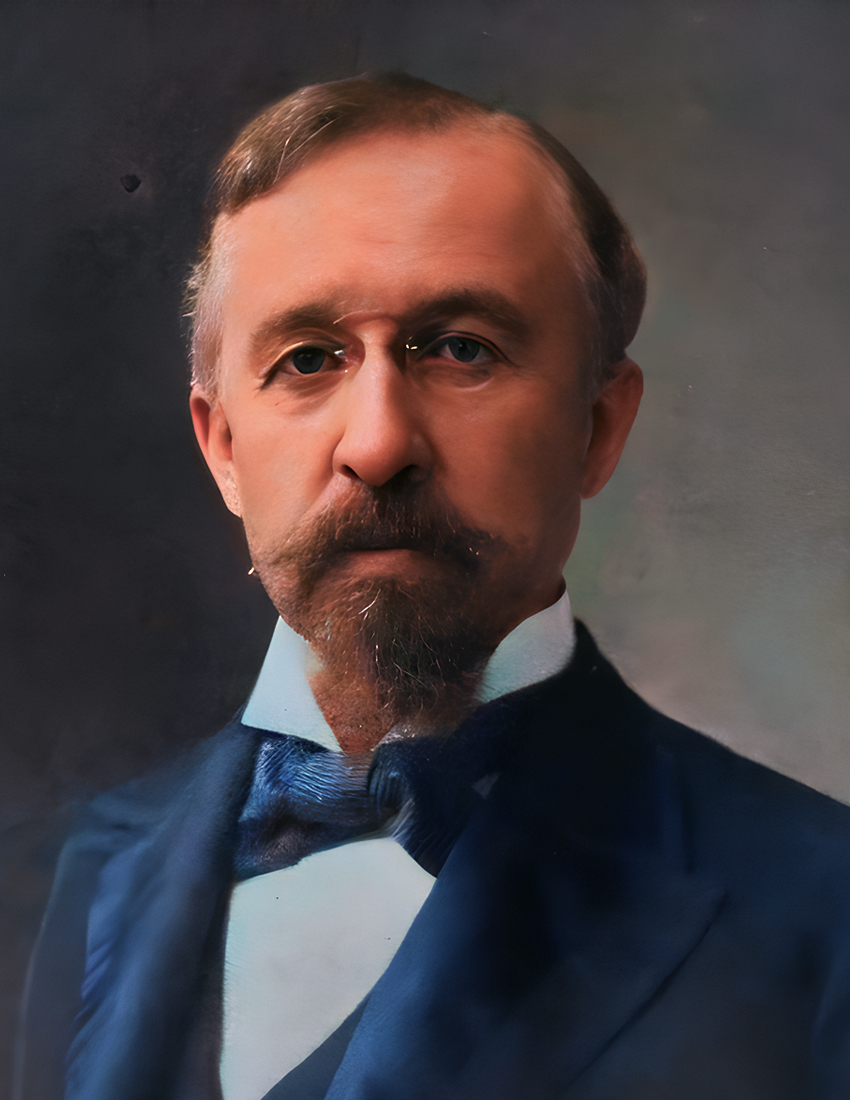Born: February 26, 1846, East Carlton, NY.
Died: October 6, 1945, Catskill, NY.
Buried: Maple Grove Cemetery, Kew Gardens, Queens, NY.
George Coles Stebbins

Hymns by George Stebbins
A Voice for the Gospel
Born on February 26, 1846, in Orleans County, New York, George Coles Stebbins would go on to become one of the most influential composers, hymn writers, and singing evangelists of his generation. His voice, his pen, and his passion for the gospel left an indelible mark on the world of sacred music.
Early Years and Musical Beginnings
Stebbins spent the first 23 years of his life on a farm in upstate New York, but his heart was always drawn to music. In 1869, he moved to Chicago, Illinois, a decision that would forever change the course of his life and ministry. It was there that he took up the position of music director at the First Baptist Church, rubbing shoulders with some of the greatest names in gospel music at the time, including George Root, Philip Bliss, and Ira Sankey.
After several years in Chicago, Stebbins relocated to Boston, Massachusetts, where he served as music director at the Clarendon Street Baptist Church under the renowned preacher A.J. Gordon. He later assumed the same role at Tremont Temple, working alongside pastor George C. Lorimer. It was during this time that Stebbins’ path would cross with another towering figure in Christian history: D.L. Moody.
Partnering with Moody in Evangelism
In the summer of 1876, while visiting Moody’s home in Northfield, Massachusetts, Stebbins was persuaded by the great evangelist to join his ministry team. This marked the beginning of a fruitful partnership that would span nearly 25 years. Stebbins became an integral part of Moody’s evangelistic campaigns, organizing choirs, leading congregational singing, and even assisting in the compilation of the beloved “Gospel Hymns” series.
Together with his wife, Elma, who was herself a gifted musician and Bible teacher, Stebbins traveled extensively with Moody and Sankey, both in the United States and abroad. They shared their musical gifts in meetings from Chicago to Calcutta, touching countless lives with the power of gospel song.
A Composer of Timeless Hymns
As much as Stebbins’ voice was heard around the globe, it is perhaps his enduring hymns for which he is best remembered. With a keen ear for melody and a heart attuned to the truth of Scripture, Stebbins penned some of the most beloved gospel songs of all time, many of which are still sung in churches today.
Who can forget the gentle invitation of “Jesus Is Calling,” the earnest plea of “Jesus, I Come,” the prayerful reflection of “Take Time to Be Holy,” or the surrendered devotion of “Have Thine Own Way, Lord”? These Stebbins classics continue to inspire and encourage believers of all ages and backgrounds, reminding us of the simple yet profound truths at the heart of the gospel. With their memorable melodies and heartfelt lyrics, they call us to a deeper relationship with Christ, a life of holiness and trust in the One who loves us with an everlasting love.
Stebbins had a rare gift for capturing the essence of the Christian faith in simple, singable verses. His songs were not mere entertainment, but powerful vehicles for proclaiming the gospel and drawing people into the presence of God. He understood that music has a unique way of imprinting truth on the mind and heart, and he used that knowledge to full effect in his compositions.
A Friendship Forged in Song: George Stebbins and Daniel Towner
Among the many remarkable friendships that emerged from the gospel music scene of the late 19th century, the bond between George Stebbins and Daniel Towner stands out as a shining example of brotherly love and shared passion for the cause of Christ. Though their paths first crossed at the Northfield Conferences in 1886, their connection would grow into a lifelong partnership in ministry and music.
Stebbins recounts their initial meeting with fondness, noting how D.L. Moody had been so impressed with Towner’s leadership and singing at a previous event in Kentucky that he invited him to join the roster of musicians and evangelists at Northfield. Towner quickly proved his worth, being selected to lead the singing at the inaugural College Student Conference held at Mount Hermon that year.
As the student conferences grew in popularity and influence, attracting future luminaries like Robert E. Speer and John R. Mott, Towner and Stebbins became fixtures at these gatherings. Towner continued to lead the music for the men’s conferences, while Stebbins took charge of the singing for the newly established women’s meetings.
Stebbins’ admiration for Towner’s musical gifts and leadership abilities is evident throughout his reminiscences. He describes his friend as “universally acknowledged as a musician of the first rank and a leader of unusual ability,” high praise from a man who himself was no stranger to talent and acclaim. The two collaborated on several projects over the years, including the compilation of a hymnal titled “Best Endeavor Hymns,” a testament to their shared commitment to providing the church with quality music for worship.
But their friendship was not confined to the rehearsal room or the conference stage. Stebbins fondly recalls an amusing incident where he, Towner, and Ira Sankey were conscripted by D.L. Moody to provide musical support for a Sunday morning service at a small church near Northfield. As the men filed into the sanctuary, their varying heights created a rather comical “stair-step” effect, with Moody at the bottom and Towner towering over the rest. The congregation’s amused reaction hints at the warm camaraderie and good-natured humor that characterized the relationship between these musical ministers.
Even as their individual careers took them in different directions – Towner to his long tenure as music director at the Moody Bible Institute, Stebbins to worldwide evangelistic tours and leadership roles – their paths continued to cross and their friendship endured. Biographical accounts note Towner’s presence at social gatherings in London hosted by Stebbins, suggesting a bond that extended beyond the professional realm.
A Life of Faithful Service
Throughout his long and fruitful ministry, George Stebbins remained a humble and dedicated servant of Christ. Whether leading a choir of thousands at a Christian Endeavor convention or lending his voice to a small evangelistic meeting, he gave his all for the sake of the gospel.
Stebbins was the last surviving member of D.L. Moody’s original circle of evangelists, a group that included luminaries like Ira Sankey, Philip Bliss, and D.W. Whittle. His faithful service at the Northfield Conferences, Moody’s summer gatherings in Massachusetts, spanned over three decades. He was a constant and steadying presence, a man whose life was a testament to the power of music in the hands of a consecrated believer.
A Legacy that Endures
When George Coles Stebbins passed away on October 6, 1945, at the age of 99, he left behind a rich legacy of gospel music that continues to bless and inspire. His songs, born out of a deep love for God and a passion for souls, have stood the test of time, crossing generational and cultural boundaries with their timeless truths.
As we sing these beloved hymns today, we can almost hear the echo of Stebbins’ clear, strong voice leading the way. We can picture him at the piano, pouring his heart into every note and phrase, inviting us to join in the chorus of praise. And we can thank God for the life of this faithful servant, whose music will continue to point hearts heavenward until that glorious day when all the redeemed will sing together around the throne.
So let us take up the songs that George Stebbins left us, and let us sing them with renewed conviction and joy. Let us make them our own prayers and praises, our own declarations of faith in the God who saves by grace. And let us carry on the legacy of this humble yet mighty man of God, using our own gifts and talents to share the good news of Jesus Christ with a world in need.
That is the enduring testimony of George Coles Stebbins, a life poured out in service to the gospel song.

